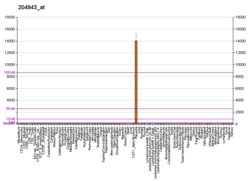Clinical Significance
ADAM 12, a metalloprotease that binds insulin growth factor binding protein-3 (IGFBP-3), appears to be an effective early Down syndrome marker. Decreased levels of ADAM 12 may be detected in cases of trisomy 21 as early as 8 to 10 weeks gestation. Maternal serum ADAM 12 and PAPP-A levels at 8 to 9 weeks gestation in combination with maternal age yielded a 91% detection rate for Down syndrome at a 5% false-positive rate. When nuchal translucency data from approximately 12 weeks gestation was added, this increased the detection rate to 97%. [9]
ADAM12 has also been implicated in the development of pathology in various cancers, hypertension, liver fibrogenesis, and asthma. [10] In asthma, ADAM12 is upregulated in lung epithelium in response to TNF-alpha. [11]
In a study of about 1200 persons with extremely high intelligence (IQ about 170), variants of the gene were associated with high IQ compared with a general population. [12]
This page is based on this
Wikipedia article Text is available under the
CC BY-SA 4.0 license; additional terms may apply.
Images, videos and audio are available under their respective licenses.






